Posted by Elena del Valle on April 27, 2020

Hilary Topper, author, Branding in a Digital World
Photo: HJMT Public Relations
A podcast interview with author Hilary Topper is available in the Podcast Section of Hispanic Marketing and Public Relations, HispanicMPR.com. During the podcast, she discusses her book Branding in a Digital World with Elena del Valle, host of the HispanicMPR.com podcast.
Since 1992 Hilary has been the chief executive officer of HJMT Public Relations. She is also adjunct professor at Hofstra University, where she teaches digital communication, public relations tools, and persuasive presentation for undergraduate and graduate students.
Since 2011 she is the host of a weekly podcast (Hilary Topper On Air) and chief curator of HJMT Media Company, LLC, where she writes for two blogs, NYLifestyleBlog.com and ATriathletesDiary.com. According to her biography her blogs receive more than 50,000 unique visitors a month.
She wrote Branding in a Digital World to offer small business owners information on how to grow their businesses through digital media. Her first book, Everything You Ever Wanted to Know About Social Media, but were afraid to ask… was published in 2009.
To listen to the interview, scroll down and click on the play button below or locate the “Podcast” section on the right hand side, then choose “HMPR Hilary Topper” or download the MP3 file to your iPod or MP3 player to listen on the go, in your car or at home from the RSS feed. Some software will not allow flash, which may be necessary for the podcast player. If that is your case, you will need to download the file to play it. To download it, click on the arrow of the recording you wish to copy and save it to disk. The podcast will remain listed in the April 2020 section of the podcast archive.

Click to buy Branding in a Digital World
Posted by Elena del Valle on April 22, 2020
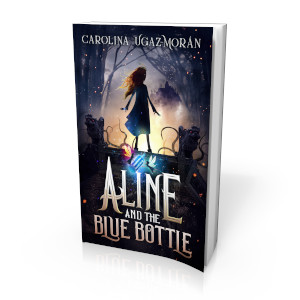
Aline and the Blue Bottle
Photos: Damonza (book cover), Farshad Khoshroo (author photo)
Carolina Ugaz-Moran, a native of Spain raised in South America and the United States with degrees in biochemistry and creative writing from the University of Wisconsin, spent ten months spread over 15 years writing Aline and the Blue Bottle, her first book. The 303-page softcover book published in 2019 includes Spanish and Quechua words, a map at the beginning as well as a page of Spells and a glossary at the end. Her target audience? Children eight to twelve years old and older.
“The cover depicts Aline standing on the House of Haunted Gargoyles facing her future, a magical floating castle with mysterious creatures flying around,” the author said by email when asked about the cover art. “She is at the entrance of a forest, with vines that surround her and behind her are her two loyal and close magical friends carrying the blue bottle. The cover also holds secrets (just like within the book).”
She went on to explain, “The title highlights Aline, her adventure, and her first quest to find the blue bottle and save many worlds. It also shows strength, courage,passion, and empowerment – in this case for a girl, depicting mysteries and magic which Aline and her friends will have to face together.”
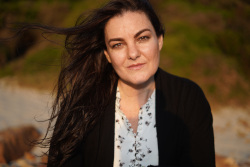
Carolina Ugaz-Moran, author, Aline and the Blue Bottle
When asked why she included Quechua she said, “I think the more exposed we are to languages as children, the more neurons we connect and the better we can develop the ability to become multilingual, so why not add Quechua and Spanish! But for me, it is more than learning a new language, it is about understanding a culture and exposing oneself to the abundance fountain of knowledge that each language provides.
Also, a few years ago, I found out that even though several people can speak Quechua (8-10 million people) very few people can actually read and write it due to the lack of printed material in Quechua. There have been efforts from the Peruvian, Ecuadorian, and Bolivian governments to introduce the language as an intercultural bilingual education; however, some indigenous people in each of these countries are having their children study in Spanish for the purpose of social and economical advancement. I thought I tried to help out a little plus I can learn on the way. Fun fact: there are about 45 varieties of Quechua which are all classified as separate languages and in addition, there are several dialects.”
When asked if her biochemistry studies help her or play a role in the project she said, “Yes, as well as my love for science and nature. This can be seen in several places. The chimera twins. They are powerful sylph sisters who have an important role in the book series. A chimera is a single organism that contains two sets of DNA with the code to make two separate organism. Simply put, it is an organism made up of cells from two or more different individuals.
The explanation of magic and how it flows, it somewhat reflects the states of energy as well as the law of conservation of energy. The blue and red stars and how from earth, the cooler stars appear red, and the high temperature stars appear blue. The symbiotic relationship between sharks and remora fish, I am an animal lover and I am looking for ways for people to admire and be kind to even the scariest of animals.”
She is working on the second book in the Aline series. It will be called Aline and the Kron Queen.

Click to buy Aline and the Blue Bottle
Comments:
Filed Under: Books
Posted by Elena del Valle on April 1, 2020
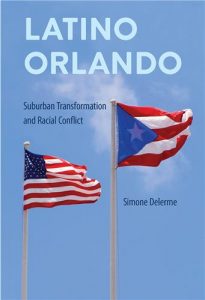
Latino Orlando
Photos: Simone Delerme
Simone Pierre Delerme, Ph.D. is McMullan associate professor, University of Mississippi’s Center for the Study of Southern Culture and Department of Sociology and Anthropology. Targeting college students, educators, policy makers, and others interested in migration experiences she wrote Latino Orlando Suburban Transformation and Racial Conflict (University of Florida Press, $80), a 181-page hardcover book mainly about Puerto Ricans in the Orlando area published this year.
“The intended academic audience includes undergraduate students and scholars in the disciplines of Anthropology, Sociology, Latino Studies, American Studies, Southern Studies, and Florida Studies,” she said by email. “The book is concise and intentionally written in simple enough language to be adopted by introductory undergraduate courses in all of these disciplines, but the engagement with critical race theory will appeal to more theoretically driven, advanced audiences.”
The most significant finding or takeaway from the book? “Latino migrants are complicating racial categorizations and challenging the deep-rooted black-white binary that has long prevailed in the American South. Language and the changing soundscape became a way of racializing and segregating Latino communities, leading to the growth of suburban ethnic enclaves,” she said.
“The research was conducted in the counties that are referred to as Greater Orlando or the Orlando Metropolitan Statistical Area,” she said when asked about the title. “Therefore, I wanted to include the term ‘Orlando’ in the title so audiences knew the part of the south that I focus on. The population I focus on is primarily Puerto Rican, but does include the voices of other Latinos. Therefore, the term ‘Latino’ was more inclusive and representative of the population documented in the book.”
The book features Introduction: New Destinations; Buenaventura Lakes; Latinization, Landscapes, and Soundscapes; The Fractured American Dream; Social Class Distinctions and the Latino Elite; The Encargado System; and Conclusion. The first three chapters focus mainly on Puerto Ricans and a Puerto Rican concentrated residential and commercial enclave, the author said. The next two chapters, about Latinos involved in business networking organizations and the Encargado System, features Cuban, Colombian, Guatemalan, Venezuelan, and Mexican perspectives.
When asked about the term Latino or Hispanic she said, “In the book, I use the terms Latino and Hispanic interchangeably, although there is a difference. Most of my informants and interviewees preferred to be identified as ‘Mexican,’ ‘Venezuelan,’ or ‘Colombian,’ for example. When they did use one of the umbrella ethnic terms, the preference was actually Hispanic, not Latino. It really depended on the individual’s preferences though, which is why I use both terms. I try to use the language that my interviewees and informants use to describe themselves. The term Puerto Rican is also tricky because those from the diaspora are sometimes identified and perceived as Nuyorican, and there is a distinction made between those from the island of Puerto Rico and those that were born and raised in New York City, for example. I use the term Puerto Rican if my interviewees and informants identified that way. Usually those who were born on the island of Puerto Rico or have family from Puerto Rico identified as Puerto Rican.”

Simone Delerme, author, Latino Orlando
“The term Hispanic, which the United States Census Bureau created in the 1970s, refers to all people in the United States whose ancestry is from one or more Spanish-speaking countries,” she said to explain how she distinguished Hispanic from Latino in the book. “The term thus emphasizes language, not geographic origin, as the identifying factor. The term Latino, which originated within the community, instead focuses on geography and is ‘an attempt to embrace all Latin American nationalities, including those which neither have ties to Spain nor are necessarily Spanish-dominant groups,’ such as Brazilians and various indigenous groups living in Latin America.”
Delerme specializes in migration to the United States South, with interests in race relations, integration and incorporation, community development, and social class inequalities. The book cover is based on a photograph Delerme took of a house in the Buenaventura Lakes suburb that had an American flag and Puerto Rican flag flying in the front lawn. She is conducting fieldwork for a second book, International Memphis: Migration and Transformation in the Mid-South. She is researching “how migrants are being incorporated into the social, political, and economic life of Memphis, Tennessee, a city with a history of segregation and a historic black-white racial binary.”
From idea to publication the project required 10 years. She received an in-residence fellowship from the Center for Puerto Rican Studies at City University of New York (CUNY) Hunter College after she completed her data collection. She is also Truman Scholar, which includes a financial award, which facilitated the fieldwork and data collection for the book. None of the informants or interviewees mentioned in the book was compensated financially, she said.
The book is part of the Southern Dissent series, which seeks to explore and analyze the role of dissent in the south, and document the experiences of dissenting groups during different time periods and in different places.

Click to buy Latino Orlando
Comments:
Filed Under: Books
Posted by Elena del Valle on March 25, 2020

Branding in a Digital World
Photos: HJMT Public Relations
Hoping to reach an audience of small businesses Hilary Topper, chief executive officer, HJMT Public Relations, wrote Branding in a Digital World How to Take an Integrated Marketing Approach to Building a Business (iUniverse, $20.99), a 278-page softcover book published last year. Written in an easy to read style the book, divided into 38 chapters, emphasizes positive outcomes. Each chapter ends with the author’s observations on the topic. The author funded the book with her savings. She said by email that no third parties donated to or funded her book project in any way; she didn’t compensate anyone for interviews or for permission to share their story.
In response to a question on what prompted her to write the book the adjunct professor at Hofstra University said, “I have been teaching a course in Digital Communications for the last six years. To make it more fun for the students, I ask them to develop their brand. Then we work on an integrated marketing plan together. I decided to write this book last year and started writing it in April 2019. I had it finished and at the publisher in December 2019.”
Her goal? “I hope that I can help business owners learn to become a little more structured and think more about how to brand and market themselves so that they have a direction. The most important thing is determining who your buyers are and then developing a plan.” Asked what makes her book stand apart she said, “It’s more of a workbook so that a small business owner can use it as a tool to get them to the next level.”
Asked about the importance of diversity she said, “Diversity in almost any business is important. But, different groups are in different places. Once you know who your buyers are, you will know where they live and how to market to them.”
When asked about her greatest challenge writing the book, she replied, “This book was a challenge. I interviewed 30+ people, did a ton of research and used some of the materials from my course. Pulling it together was a great accomplishment. Seeing it in my students hands makes me feel proud.”
When asked about the ethical line readers such be mindful of when promoting their businesses she said, “You need to feel good about what you promote and be able to sleep at night. If I don’t want to work with someone, I won’t do it, no matter how much I could get paid.”

Click to buy Branding in a Digital World
Comments:
Filed Under: Books
Posted by Elena del Valle on January 30, 2020
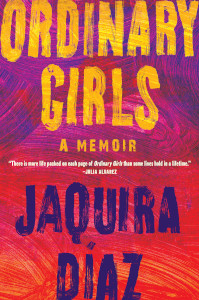
Ordinary Girls
Photos: Maria Esquinca
In Ordinary Girls A Memoir (Algonquin Books of Chapel Hill, $26.95), Jaquira Diaz describes the struggles she suffered growing up in a mixed race family first in Puerto Rico and then Florida. The 321-page hardcover non fiction book was published in 2019. Before finding success as a writer the neglected daughter of a drug addicted schizophrenic mother and absent father was a self described juvenile delinquent who was repeatedly arrested, and a drug abusing high school dropout.
Her fluid writing and storytelling belie dark gritty memories of maternal child abuse, deep sibling rivalry with her older brother, rape (references to violence remain off screen), suicidal tendencies and rage. Spanish words are peppered liberally as she paints a vivid image of her life and her childhood friends.
The book is divided into four main sections: Made Patria, Monstruo, Familia and Regresando. It includes bits about the history of the island and the failed efforts of some Puerto Ricans for independence from the United States.

Jaquira Diaz, author, Ordinary Girls
Questions submitted twice by email to her publishing company, by email and via Twitter to the author received no reply by the publication date for this article. Diaz received two Pushcart Prizes, an Elizabeth George Foundation grant, and fellowships from the MacDowell Colony, the Kenyon Review and the Wisconsin Institute for Creative Writing.

Click to buy Ordinary Girls
Posted by Elena del Valle on January 22, 2020
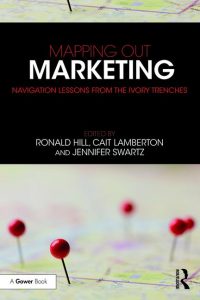
Mapping Out Marketing
Photos: Routledge Taylor & Francis Group
Ronald Hill, Ph.D. and Cait Lamberton dedicated two years to editing Mapping Out Marketing Navigation Lessons From The Ivory Trenches (Routledge,$39.95), a book targeting marketing students and marketing practitioners. The 193-page softcover book co-edited with Jennifer Swartz, a graduate student, features 55 entries (23 men and 22 women) from multiple academics. Submissions were limited to 500 words each as was the introduction. Proceeds from the book were earmarked for scholarships for underrepresented doctoral students.
“The American Marketing Association played a significant role in helping us find a publisher for our work,” Hill said by email (when approached by email Lamberton referred questions to Hill). “That is an important step that required putting their reputation on the line for our idea.”
When asked what prompted them to search this topic now Hill said “There is so much accumulated wisdom among marketing professors from around the world that does not get to folks interested in marketing practice. Most the self-help books have one good idea that they expand into an entire book. Why not have a book with many such ideas that cover a vast terrain!
Why not now? This wisdom is as necessary today as it ever will be. Let marketing professionals learn what we have to say and use what is most relevant!”
Referring to the meaning of the subtitle he said, “Ivory trenches are the difficult environments professors must navigate every day. So many outsiders think that we stay in our ‘ivory towers’ and ignore the world around us. Instead, we are embedded in a very difficult environment to maneuver and the lessons learned are profound!”
Beyond the distribution of a press release how has the book been promoted? “Our hope is that all contributors will tell two friends and so on and so on … It should be in every class and executive program around the world!”
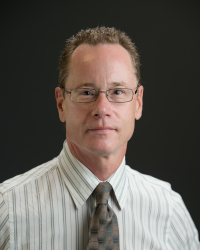
Ronald Hill
Another book may follow. Hill said, “I’d like a new volume on marketing ethics that takes practice and infuses it with values. For example, marketers are good at deciding who they want to sell to, but does it align with all the people who could gain from purchase despite societal prejudices, poverty, and other forms of restriction? We CAN make the world a better place and still thrive as an organization. We just need to consider deeply what that means.”
When asked by email about the scholarship funds an American Marketing Association spokesperson declined to respond on the record. When asked the same question Hill said, “All royalties received from sales of this book go directly to the AMA, and we have no other financial connection with the publisher.”
Hill is a visiting professor of Marketing and holds a Dean’s Excellence Faculty Fellowship at the American University, Kogod School of Business. He is chair, Transformative Consumer Research Committee and recipient of 2019 American Marketing Association Wilkie Marketing for a Better World Award. He has authored over 200 journal articles, books, chapters, and conference papers on impoverished consumer behavior, marketing ethics, corporate social responsibility, human development, and public policy.
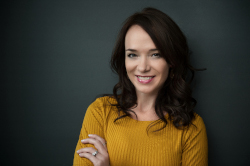
Cait Lamberton
According to promotional materials, Lamberton is associate professor and Ben L. Fryrear Chair in Marketing at the University of Pittsburgh’s Katz Graduate School of Business, where she researches and teaches consumer behavior and applied behavioral economics at the MBA and Ph.D. levels, in addition to providing consulting services in government and the private sector.
In 2018, Swartz was a full-time MBA student at George Washington University with a focus on operations, strategy, and brand management. Prior to George Washington, she worked in Corporate Communications at Marsh & McLennan Agency in San Diego, overseeing various aspects of digital media strategy, branding, public relations, and non-profit fundraising efforts.

Click to buy Mapping Out Marketing
Comments:
Filed Under: Books
Posted by Elena del Valle on November 6, 2019

Drying Up
Photos: John Dunn, Susan Dunn
Florida is approaching a crisis. The peninsula surrounded by water on three sides and with more coastal miles than any continental state save Alaska may not have enough water to serve the needs of existing residents, new residents and tens of millions of visitors in the coming years. While water issues are not new they have grown worse, according to John Dunn, author of Drying Up: The Fresh Water Crisis in Florida (University Press of Florida, $24.95).
Drawing on more than one hundred interviews and years of research he points out that pollution, failing infrastructure, increasing outbreaks of toxic algae blooms, and pharmaceutical contamination are worsening water quality. Climate change, sea level rise, and groundwater pumping are spoiling freshwater resources with saltwater intrusion. Shortages have prompted fights over rights to the Apalachicola River, Lake Okeechobee, and the Everglades among other important watersheds.
Population growth is accelerating a difficult situation, he says. In the not too distant future water scarcity may force municipalities to offer residents toilet-to-table “reused water.” In the book, he outlines the history of water in the Sunshine State and some of the most salient fresh water concerns.
“I am a native Floridian, veteran freelance writer, teacher, and environmental activist,” the author replied by email when asked what prompted him to write the book now. “With these perspectives it hasn’t been hard for me to detect the degradation of our water resources over the years. They aren’t new. They are only growing worse. A friend of mine Cynthia Barnett, a former staffer with Florida Trend Magazine, caught the attention of many Floridans about a decade ago with her book, Mirage. Unfortunately, there has been little improvement addressing our water issues.
I originally queried the editorial staff of the University Press of Florida (UPF), wanting to write a Florida-specific book on climate change. UPF already had such a book in production. But the editor asked me if I’d like to write a different one on Florida’s water woes instead. I’d written on water issues for magazines in the past. In addition, I’d worked with various conservation groups. So, I had a background in water issues and experience which I could draw on. I submitted up a book outline and got a contract.”
From idea to publication the hardcover book took Dunn two and a half years to complete. He wrote for general readers, relying on a magazine style of writing to make it reader friendly. The book struck a cord because he has received many invitations for book presentations across the state, including the Miami Book Fair this month.
“During the Q&A at these presentations, I’ve noticed that many people, especially those that have recently moved here, are either surprised or shocked to realize how impaired our waters are,” he said.
How soon should we expect the toilet-to-table water stage in Florida? “Experts told me it will be at least a decade from now, if that soon, before many Floridians are able to get over the ‘yuk’ factor associated with drinking recycled or ‘reuse’ water. One way of reusing waste water is the indirect method. This is the what many people in Tampa would like to explore; that is, pumping treated wastewater deep into the ground beneath the ‘shallower aquifer’ (from which we extract drinking water). There, presumably, the sunken, treated water will mix with existing ground water and get an extra dose of filtration as it moves through the subterranean world before it is extracted topside as drinking water.
The other method is to treat wastewater with advanced methods and then pipe it directly to a facility where it is blended with the utility’s water supply. Astronauts use this method in outer space when they treat and recycle their own urine. The people of Singapore, facing critical water shortages, now drink this direct potable ‘reuse’ water, which they call NEWater.”
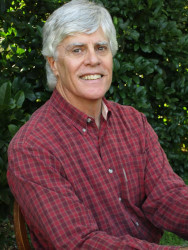
John Dunn, author, Drying Up
When asked what he would like to accomplish from writing the book he said, “I hope my book provides a ‘primer’ for readers which will give them the confidence to become citizen water activists. Anyone contemplating a move here, especially those hoping to do business in the state, should investigate both the availability and reliability of water supplies.They also need to evaluate the impact their own possible arrival could make on Florida water. Americans are used to thinking about their ‘Carbon Footprint.’ Increasingly here in Florida and the world, people are realizing they must also now calculate their ‘Water Footprint.’
As I’ve explained in Drying Up, Central Florida is already drawing water faster from the ground than it is being recharged by rainfall. South Florida is not far behind in being in the same situation.”
What can Florida residents do to secure clean water in the coming decade? “The biggest problem to Florida’s water supply is our growing population, along with public indifference and the current ‘business as usual’ approach to economic activity,” the author said. “For too long, the Florida Growth Machine, developers, bankers, realtors, and their compliant political allies, have viewed Florida as a commodity, a place to be consumed for a profit. Currently, the Miam/Dade (Miami/Dade) County Commission is paving the way for construction of the largest mall in the country. The $4 billion retail and entertainment complex will be built on the edge of the Everglades. It will even provide artificial snow so shoppers can ski. This, in a subtropical setting that will face water shortages in the near future! Such insanity runs rampant in our state.
In my lifetime, I’ve seen Florida’s population jump from 2 million to 22 million. We now receive over 120 million tourists annually. The 1000 Friends of Florida 2017 study suggests that if present demographic trends continue, Florida could add another 15 million by 2070. By then, much of the state is likely to be swamped by sea level rise.
Floridians who worry about securing fresh water need to be mindful of the plight of their water supply right now. It’s amazing to me that the nation gets excited about spending billions of dollars looking for a drop of water on Mars or the moons of Saturn with the hope it could suggest the existence life, while simultaneously wasting fresh water on earth with abandon.
All of us are guilty of squandering water. Floridians use 50 percent of the state’s fresh water supply irrigating their lawns every day. Every time we flush a toilet and fertilize our yards we contribute to the ‘nutrient’ contamination of fresh water by fueling algae growth. Every time we soak our lawns with pesticides, we pollute groundwater. Every time we clear-cut Florida’s forests, wetlands, and natural vegetation, or dig canals, change the contour of the earth, and plaster the ground with asphalt and concrete, we cause the greatest damage of all to our fresh water supplies. That’s because we destroy Florida’s natural hydrologic systems. When we do this, we literally disrupt the natural evaporation, drainage and percolation of water to the aquifer.
Every day our fresh water is also being polluted from industry, storm water runoff, and aging sewage systems and water treatment plants. Meanwhile, climate change is causing extreme flooding, rising sea levels, and perhaps occasional periods of drought. All of these forces contaminate fresh water wells.
Finally, I think, Floridians need to adopt a more enlightened ‘Soft Path’ approach to water which I’ve described in the book. These means restoring wetlands and natural hydrologic systems, mimicking nature, and increasing the use of conservation and recycling. It calls for the water management districts to stop giving out new water pumping permits like library cards. It also means a shift in values. Water shouldn’t be a commodity. It is, after all, the unique, perhaps, divine substance that gives rise to life on earth.
Floridians must elect only those who also understand the natural world and will fight to protect our natural resources, not exploit them. Otherwise, developers, big business, fracking interests, and large-scale agriculture operations (ranging from the growing of sugar cane to raising cattle), will be the main water policy makers.
I hope my book will help bring about these goals.”
Dunn, a native of Miami, is a working freelance writer and journalist and a veteran high school history teacher. He has published over 350 articles for more than twenty periodicals as well as young adult books. A member of the Silver Springs Alliance, Dunn has worked for years with other volunteers to address many of Florida’s pressing environmental problems. He lives with his wife Susan in Ocala, Florida.

Minuscule commissions earned from Amazon. Links included mostly for reader convenience: Click to buy Drying Up
Comments:
Filed Under: Books
Posted by Elena del Valle on September 25, 2019
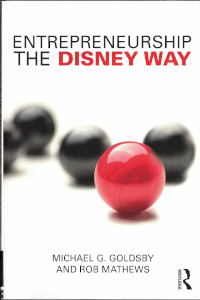
Entrepreneurship The Disney Way
Photos: Routledge, Zeller Photography, Ball State University
In Entrepreneurship the Disney Way (Routledge, $59.95) Michael Goldsby and Rob Mathews discuss their ideas about leadership and entrepreneurship modeled on the Disney company. They follow Disney’s rise from startup to media giant, highlighting how they believe the company’s leaders “carry on the legacy of Walt Disney’s mission and core values, enabling the company to continue growing and innovating.”
The 308-page softcover book published in 2019 is divided into seven chapters and two main parts: Walt Disney, Entrepreneur and Corporate Entrepreneurship at the Walt Disney Company.
“The book was written for a wide audience, but the two parts of the book target A) entrepreneurs and leaders, and B) owners, leaders, and managers of/ in mid-sized to large companies and other organizations,” Mathews said by email in response to a question about the primary target audience for the book.
When asked how long the project took from idea to publication he replied, “Mike and I developed a love for Disney Parks and Resorts in the last 15 years. We spent the last 10-12 years researching the company and specifically its parks and resorts. We started started talking about and planning a book about 10 years ago. The actual writing and editing process took about a year.”
Each chapter includes end notes and highlights Lessons, 30 in total. The first part of the book is dedicated to Walt Disney and his vision. The second part focuses on the transition from a family business to the company it is today.

Rob Mathews, co-author, Entrepreneurship The Disney Way
“Most jobs, businesses, and projects go well when they match your passion and psychological talents. Writing is no different,” Mathews said when asked why he and his co-author selected Disney as the model company for the book. “Mike and I had great knowledge of Disney as a business model, we had friends in the company, we love the company as a consumer, and we connected with the story of Walt’s vision, perseverance, and legacy that lives on today. I would also add that the way we approach our lives and business matches up with Disney very well. We value innovation, heritage, professionalism, intentionality, attention to detail, and great leadership. Disney is an exemplary model for those principles.”
In what ways does a mission developed in the 1920s remain relevant today? “Disney’s mission is timeless,” Mathews said. “It essentially hasn’t changed since Walt’s initial vision. The company’s overall mission–essentially to be the best in entertainment–and the parks and resorts mission–basically to create happiness–have more or less remained the same. Those missions are simple, inspiring, and easy to get behind as a leader, cast member, partner, or vendor. And the customer can feel and experience the Disney difference, as we like to call it.”
When asked to share examples of Disney entrepreneurship and innovation in the past three years he said, “Most of Disney’s recent innovations that come to mind have surfaced in the theme parks. Attractions like Tron Lightcycle Power Run in Shanghai Disneyland, Avatar Flight of Passage in Animal Kingdom, Slinky Dog Dash in Hollywood Studios, and Millennium Falcon: Smuggler’s Run are truly cutting edge. The parks and lands that house those attractions, Shaghai Disneyland, Toy Story Land, Star Wars: Galaxy’s Edge, Pandora – The World of Avatar, are breathtaking innovations that remove guests from the realities of their lives. Pandora literally looks like we saw it on the movie, and the Star Wars land makes you forget that you are in a theme park. Beyond attractions and theming, less noticeable, yet highly impactful system and process innovations, such as waste management at Magic Kingdom, the most visited theme park in the world, have changed the way Disney does business.”
When asked: The Millennial generation is said to be the most diverse generation yet. In what way does the model you propose take into account Millennials, diversity among workers and customers? he replied, “Our Entrepreneurial Leadership Instrument (ELI), like most assessment tools in my belief, bridge generational gaps and provide a common language for people. These tools demonstrate the value of each person, and empower people to be themselves. For a generation that was told to behave a certain way, think very specifically, and take orders, genuine and authentic use of such tools is extremely refreshing and encouraging. Millennials appreciate that kind of approach to leadership and team building. Good assessment tools also highlight the value and critical importance of cognitive diversity, along with building diverse teams. As for customers, the ELI points to the need to speak differently to different players. Not everyone will respond to marketing, mission, branding, brand promise, etc. the same, and companies need to know that and build appropriate strategies. The days of push marketing are largely over. It’s a lot like how good teachers make sure they are addressing the various learning styles in the classroom.
The Disney Company has done an excellent job of creating a very diverse culture that welcomes and provides opportunities for all people. Millennials like working at Disney because the mission is clear, positive, and constantly supported and reinforced. Millennials are very mission-centered, so Disney’s extreme emphasis on mission and investment in people in very attractive to them.”
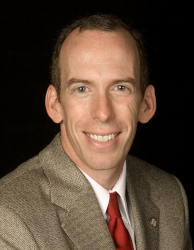
Michael Goldsby, co-author, Entrepreneurship The Disney Way
When asked about allegations of gender parity issues at Disney (see Underpaid and undervalued: 10 women claim systemic discrimination at Disney from September 18, 2019, The Guardian, theguardian.com/world/2019/sep/18/disney-lawsuit-gender-pay-gap-abc?), Mathews replied: “I can’t really speak to the media side of the company too much, as we don’t have contacts there, nor has it been our research focus. The Parks and Resorts division seems to treat all cast members extremely well, so it does not impact the concepts we shared in the book.”
Only Mathews responded to email questions. Goldsby is chief entrepreneurship officer and Stoops Distinguished professor of Entrepreneurship at Ball State University in Indiana. Mathews is the director of the Institute for Entrepreneurship and Free Enterprise at Ball State University.
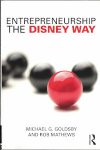
Click to buy Entrepreneurship the Disney Way
Comments:
Filed Under: Books
Posted by Elena del Valle on September 9, 2019
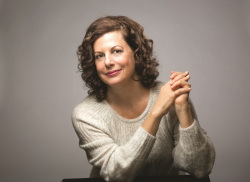
Katherine Eban, author, Bottle of Lies
Photo: Roberto Falck
A podcast interview with Katherine Eban, author, Bottle of Lies (see Investigative journalist reveals troubling side of generic drugs) is available in the Podcast Section of Hispanic Marketing and Public Relations, HispanicMPR.com. During the podcast, she discusses her book with Elena del Valle, host of the HispanicMPR.com podcast.
Katherine Eban is a Fortune magazine contributor, and has also written for Vanity Fair, Self, and The Nation. She is the author of Dangerous Doses: A True Story of Cops, Counterfeiters and the Contamination of America’s Drug Supply. She formerly worked as a staff writer for The New York Times and the New York Observer. Educated at Brown University and Oxford, where she was a Rhodes Scholar, she lives in Brooklyn with her husband and two daughters.
To listen to the interview, scroll down until you see “Podcast” on the right hand side, then select “HMPR Katherine Eban” and click on the play button below or download the MP3 file to your iPod or MP3 player to listen on the go, in your car or at home from the RSS feed. Some software will not allow flash, which may be necessary for the play button and podcast player. If that is your case, you will need to download the file to play it. To download it, click on the arrow of the recording you wish to copy and save it to disk. The podcast will remain listed in the September 2019 section of the podcast archive.
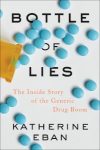
Click to buy Bottle of Lies
Posted by Elena del Valle on August 12, 2019
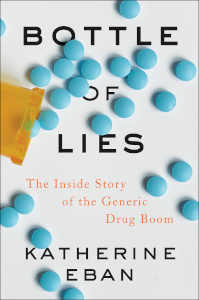
Bottle of Lies
Photos: Ecco, Roberto Falck
Investigative journalist Katherine Eban dedicated 10 years of her life to researching and writing about the generic drug industry boom in the United States. Along the way she read official documents, spoke with whistleblowers, lawyers and government employees, uncovering disturbing truths about the quality and trustworthiness of the drugs that many would prefer remain in the dark. This year her findings became available to the public in Bottle of Lies The Inside Story of the Generic Drug Boom (Ecco, $28.99). There is also an audio edition narrated by Eban. A paperback edition is due May 2020.
The 482-page non fiction book is easy to read and engaging, more like a novel than a non-fiction expose. It outlines the events that led to the blossoming of a huge generic drug industry in the United States and the myriad problems she uncovered. It is divided into 28 chapters and seven main parts: Shifting Ground, India Rises, A Cat-and-Mouse Business, Making A Case, Detectives in the Dark, The Watershed, and Reckonings.
“The book is entirely non-fiction, Eban said by email. “Every detail in the book is supported by documentation, interviews, or source recollections, and no names have been changed.”
When asked about her personal motivator, she replied, “My reporting on the generic drug industry actually began a decade ago, when I was contacted by the host of an NPR radio show, The People’s Pharmacy. The host, Joe Graedon, said that patients were contacting him with complaints about side effects from their generic drugs. He suggested I look into the question of what is wrong with the drugs. It quickly became apparent to me that just documenting patient concerns would not get me very far in answering that question. I realized the answers most likely lay in the manufacturing plants and boardrooms of the companies making our drugs – which meant in India and China.
My effort to answer that original question — What is wrong with the drugs? — turned into a global mystery that kept me reporting and digging.”

Katherine Eban, author, Bottle of Lies
The primary target audience for the book? “Anyone and everyone, the author said. “The story is real-life global thriller with big money and life-and-death consequences at its core. Anyone who enjoys a page-turning detective story, who wants to learn about the dark side of globalization, or who takes any medicine at all, is the ideal reader.”
About the book project overall the author said, “The biggest challenge was: how was I, as an independent U.S.-based journalist — without a newsroom, a team of colleagues, or other resources at my disposal — going to be able to penetrate an industry, and companies, that were based on another continent? The difficulties of a global investigative project were unrelenting.
The most rewarding was finally being able to get real insight into those distant manufacturing plants, and to convey that to readers. The reaction has been immense. I am flooded with emails from grateful readers, almost all of whom are consumers of generic drugs. They feel enlightened by the book.”
Eban said that since the book came out, she has been contacted by Congressional committees, interested in investigating the problems she raised. One measure of success, the author said, would be to help fix the problems her book exposes.

Click to buy Bottle of Lies



































